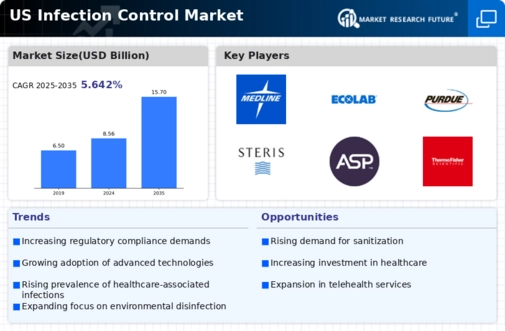Regulatory Initiatives and Guidelines
Regulatory bodies in the US are increasingly implementing stringent guidelines and standards aimed at reducing surgical site infections. These regulations compel healthcare facilities to adopt comprehensive infection control measures, thereby driving the surgical site-infection-control market. The Centers for Disease Control and Prevention (CDC) and the Joint Commission have established protocols that healthcare providers must follow to minimize the risk of SSIs. Compliance with these regulations not only enhances patient safety but also reduces the financial burden associated with SSIs, which can cost hospitals up to $30,000 per infection. As a result, healthcare facilities are investing in infection control products and training programs to meet these regulatory requirements, contributing to the market's expansion. The emphasis on accountability and quality care is likely to sustain this trend in the coming years.
Rising Incidence of Surgical Procedures
The increasing number of surgical procedures in the US is a primary driver for the surgical site-infection-control market. As the population ages and the prevalence of chronic diseases rises, more individuals require surgical interventions. According to recent data, the number of surgeries performed annually in the US is projected to exceed 50 million by 2025. This surge in surgical activity heightens the risk of surgical site infections (SSIs), thereby amplifying the demand for effective infection control solutions. Hospitals and surgical centers are compelled to adopt advanced infection control measures to mitigate these risks, which in turn propels growth in the surgical site-infection-control market. The focus on improving patient outcomes and reducing healthcare costs associated with SSIs further underscores the importance of robust infection control practices.
Increased Awareness of Infection Prevention
There is a growing awareness among healthcare professionals and patients regarding the importance of infection prevention in surgical settings. This heightened awareness is significantly influencing the surgical site-infection-control market. Educational campaigns and initiatives by health organizations emphasize the risks associated with SSIs and the necessity for stringent infection control protocols. As a result, healthcare facilities are increasingly investing in advanced sterilization technologies and infection control products. The market is expected to witness a compound annual growth rate (CAGR) of approximately 8% over the next few years, driven by this awareness. Furthermore, patients are becoming more informed and are actively seeking hospitals with robust infection control measures, thereby creating a competitive landscape that encourages facilities to enhance their infection prevention strategies.
Technological Innovations in Infection Control
Technological advancements play a crucial role in shaping the surgical site-infection-control market. Innovations such as antimicrobial coatings, advanced sterilization equipment, and real-time monitoring systems are transforming infection control practices in surgical environments. For instance, the introduction of robotic-assisted surgical systems has been shown to reduce the incidence of SSIs due to enhanced precision and reduced tissue trauma. The market for these technologies is projected to reach $5 billion by 2026, reflecting a growing investment in cutting-edge solutions. Additionally, the integration of artificial intelligence and machine learning in infection control protocols is expected to optimize infection prevention strategies, further driving market growth. As healthcare providers seek to improve patient safety and outcomes, the demand for these innovative technologies is likely to increase.
Growing Focus on Patient Safety and Quality of Care
The increasing emphasis on patient safety and quality of care is a significant driver for the surgical site-infection-control market. Healthcare providers are under pressure to improve patient outcomes and reduce the incidence of SSIs, which can lead to prolonged hospital stays and increased healthcare costs. Initiatives such as the National Surgical Quality Improvement Program (NSQIP) aim to enhance surgical care quality by promoting best practices in infection prevention. As hospitals strive to achieve higher safety ratings and patient satisfaction scores, they are more likely to invest in effective infection control measures. This focus on quality care is expected to propel the surgical site-infection-control market, with projections indicating a potential market value increase of 10% annually. The alignment of financial incentives with quality improvement initiatives further underscores the importance of robust infection control practices.






















Leave a Comment